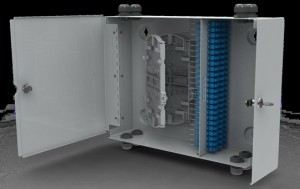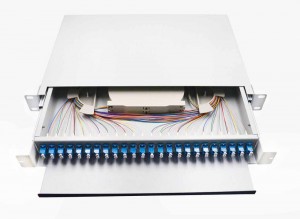What Is ODF?
An optical distribution frame (ODF) is a frame used to provide cable interconnections between communication facilities, which can integrate fiber splicing, fiber termination, fiber optic adapters & connectors and cable connections together in a single unit. It can also work as a protective device to protect fiber optic connections from damage. The basic functions of ODFs provided by today’s vendors are almost the same. However, they come into different shapes and specifications. To choose the right ODF is not an easy thing.
Types of ODF
According to the structure, ODFs can mainly be divided into three types, namely wall mount ODF, floor mount ODF and rack mount ODF.
Wall mount ODF (shown in the following picture) usually uses a design like a small box which can be installed on the wall and is suitable for fiber distribution with small counts. Floor mount ODF adopts closed structure. It is usually designed with relatively fixed fiber capacity and nice appearance.

Rack mount ODF (shown in the following picture) is usually modularity in design with firm structure. It can be installed on the rack with more flexibility according to the fiber optic cable counts and specifications. This kind of optical distribution system is more convenient and can provide more possibilities to the future variations. Most of the rack mount ODF is 19”, which ensures that they can be perfectly installed on to the commonly used standard transmission rack.

ODF Selection Guide
The selection of the ODF is not limited to the structure, many factors like applications should be considered. Some of the most important are introduced as following.
Fiber Counts: with the number of fiber connections in places like data center increase, the need for high density ODF become the trend. And it is very common to find ODF with 24 ports, 48 ports or even 144 ports for fiber optic cables in the market now. Meanwhile, many vendors can provide the customized ODFs according to the customers’ requirement.
Manageability: High-density is the good but management is not easy. ODF should provide an easy management environment for technicians. The basic requirement is ODF should allow for easy access to the connectors on the front and rear of those ports for insertion and removal. This requires that ODF should reserve enough space. In addition, the color of adapters installed on the ODF should be remain consistent with the color code of fiber optic connectors to avoid wrong connections.
Flexibility: as mentioned rack mount ODF is relatively flexible during applications with the modular design. However, anther aspect which can increase the ODF’s flexibility effectively is the port size for adapters on the ODF. For example, an ODF with ports of duplex LC adapter size can be installed with duplex LC, SC or MRTJ adapters. An ODF with ports of ST adapter size can be installed with both ST adapters and FC adapters.
Protection: optical distribution frames integrate fiber connections in it. The fiber connections like splicing joint, fiber optic connectors are actually really sensitive in the whole transmission network and is directly related to the stability and reliability of the network. Thus, a good ODF should have protection device to prevent fiber optic connections from damages produced by dust or stress.
 HANSUN
HANSUN 